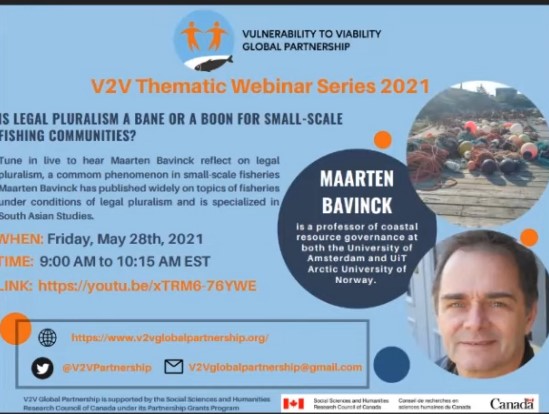 The May 28 webinar of the V2V Project featured Dr Maarten Bavinck of Amsterdam University as keynote speaker. Starting out from his basis as a development sociologist and interested in governance, he spoke about nowadays common situations of legal plurality. The term describes a context where typically traditional laws and regulations apply to the same geographical space as modern positive law.
The May 28 webinar of the V2V Project featured Dr Maarten Bavinck of Amsterdam University as keynote speaker. Starting out from his basis as a development sociologist and interested in governance, he spoke about nowadays common situations of legal plurality. The term describes a context where typically traditional laws and regulations apply to the same geographical space as modern positive law.
Small-scale fisheries as a largely informal and widely distributed type of social activity might have been largely left to its own devices perhaps half a century ago and developed its own sets of regulation for access to water and land resources needed for fishing and postharvest activities. These rules and regulations were seldomly written up and sometimes it was not even clear to outsides who might be office bearers with responsibility for enforcement and possible sanctions in case of transgression. Such customary law can be in parallel or sometimes in open competition to state law, which is often based on other principles and guided by different values or intent on protecting other groups of people.
In addition to national legislation there is also a growing body of international treaties, rules and regulations, which may not be compatible with customary law or religious beliefs governing people's behaviours and practices, for example when the latter discriminate against women. He cited a number of examples from Southern India to illustrate the complexities.
This legal plurality is often a fact, like it or not. Maarten suggested that it might be best to consciously engage in working out feasible compromises between different sets of rules through co-management processes. He cautioned that this can take time and requires all parties to demonstrate respect for one another and build trust as a basis for agreements. He suggested that in some cases, intermediate institutions might be needed for some form of reconciliation or agreed definition of whose authority has priority depending on the type of conflict to be solved. The lively Q&A session following the lecture was a welcome opportunity to go deeper also into some case material. Click here to enjoy the entire webinar.








